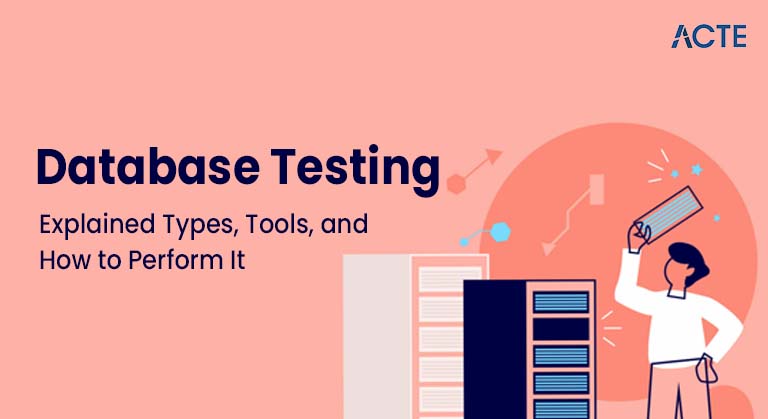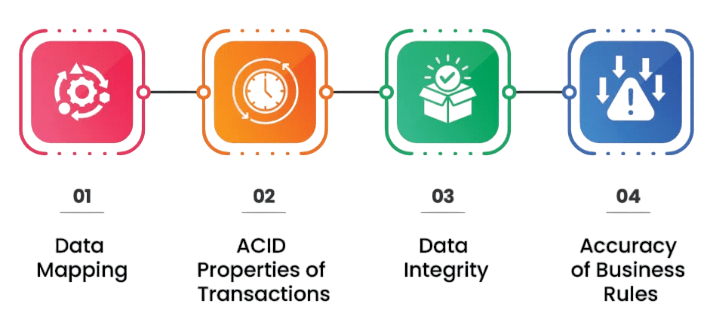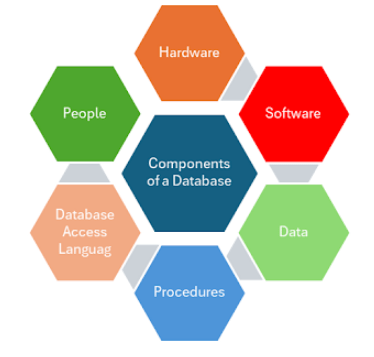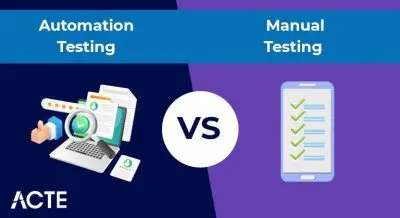
- Introduction
- Why is Database Testing Important
- Types of Database Testing
- Key Components of a Database
- How to Perform Database Testing
- Tools Used in Database Testing
- Manual vs Automated Database Testing
- Conclusion
Introduction
When discussing software testing, the focus often centers on the user interface, as it represents the visible part of an application that users interact with. However, beneath the surface lies a crucial component that drives most application functionality, the database. In any data-driven application, the database plays a vital role in storing, retrieving, and processing information. This is where Database Testing becomes essential, ensuring that backend operations function accurately, securely, and efficiently. Database Testing involves verifying the integrity and consistency of data as it moves through different layers of the application. It ensures that data input through the UI is correctly stored in the database, and that the output displayed to the user reflects accurate and expected results. This form of testing also validates that relationships between tables are correctly maintained, data constraints are enforced, and transactions are executed as intended without data loss or corruption. Beyond data accuracy, Database Testing also examines performance under various conditions, such as high-volume data operations or simultaneous user access. It helps identify bottlenecks, inefficient queries, and potential security vulnerabilities, all of which could impact the overall performance and reliability of the application. Just as UI testing is essential for validating the visual and interactive aspects of software, Database Testing is critical for ensuring that the underlying data infrastructure supports those functions seamlessly. By verifying that data flows correctly, remains consistent, and is processed securely, Database Testing contributes significantly to a stable, trustworthy, and high-performing application. Ignoring this aspect of testing can lead to critical issues that may not be immediately visible on the surface but can severely affect the functionality and user experience.
Are You Interested in Learning More About Software Testing? Sign Up For Our Software Testing Training Course Today!
Why is Database Testing Important
Database testing plays a critical role in the software development lifecycle, ensuring that the core data layer of an application functions as intended. While much emphasis is placed on testing the user interface, the stability and reliability of any data-driven application ultimately depend on the accuracy, integrity, and performance of the backend database. There are several key reasons why database testing is essential. First and foremost, it ensures data integrity, helping to prevent issues such as data corruption, duplication, or inconsistencies. This is vital for maintaining a trustworthy and stable data environment. Data accuracy is another core aspect, as it confirms that user inputs are correctly captured, stored, and retrieved, ensuring the information displayed to users is both relevant and up-to-date. Database testing also plays a crucial role in validating application logic embedded within the database itself. This includes verifying stored procedures, triggers, and functions that often handle business rules behind the scenes

Without proper testing, these automated processes may behave incorrectly, leading to faulty data handling. In addition, database testing helps identify data loss issues, especially in scenarios involving failed transactions, system crashes, or unexpected interruptions. Ensuring that the system can gracefully handle such failures is vital for data security and continuity. It also contributes to performance improvement by checking how well indexing, queries, and database structure are optimized to handle large volumes of data efficiently. Lastly, it supports compliance with security standards, making sure that sensitive data is properly encrypted or stored in a secure manner. In short, even the most visually appealing application can fail if its data layer is flawed. Thorough database testing ensures the foundation of the application is strong, secure, and reliable.
Types of Database Testing
- Structural Testing: This type of testing focuses on the database’s architecture. It ensures that all database objects such as tables, columns, indexes, views, and schemas are correctly designed and implemented according to requirements.
- Functional Testing: Functional testing verifies the core operations of the database, specifically CRUD operations Create, Read, Update, and Delete. It ensures that these actions work correctly and that the underlying business logic and rules are properly enforced during data manipulation.
- Data Integrity Testing: Data integrity testing confirms that relationships between tables, especially primary and foreign key constraints, are properly maintained. This prevents issues such as orphan records or invalid references, ensuring data remains consistent and reliable across the database.
- Stored Procedure Testing: This testing validates stored procedures, triggers, and user-defined functions to check whether they execute correctly and return accurate results. Since these database components encapsulate business logic, thorough testing is essential for correctness.
- Performance Testing: Performance testing evaluates the database’s ability to handle high loads, such as many simultaneous users or large volumes of data transactions. It identifies bottlenecks and ensures the database remains responsive and stable under stress.
- Security Testing: Security testing checks that the database restricts access appropriately, preventing unauthorized users from viewing or modifying sensitive information. It verifies roles, permissions, and encryption mechanisms are correctly implemented to protect data confidentiality.
- Backup and Recovery Testing: This testing ensures that backup procedures work correctly and that data can be restored in case of failure or data loss. It verifies the reliability of recovery plans and the integrity of backed-up data, which is critical for business continuity.
- Tables: Tables are the fundamental components of a database where data is stored. They organize information in rows and columns, with each row representing a record and each column representing a data attribute. Testers verify that tables are correctly structured and contain the expected data types.
- Views: Views are virtual tables created by querying one or more underlying tables. They do not store data themselves but provide a way to simplify complex queries or restrict access to specific data. Testing ensures views return accurate and consistent results based on their definitions.
- Indexes: Indexes are database objects that improve query performance by allowing faster data retrieval. They work like an index in a book, helping the database find records quickly. Testers check that indexes exist where needed and do not negatively impact data modifications.
- Stored Procedures: Stored procedures are predefined blocks of SQL code stored in the database that can be executed to perform specific tasks. They encapsulate business logic and reduce redundancy. Testing validates that stored procedures run correctly and produce the expected outputs.
- Triggers: Triggers are special procedures that automatically execute in response to certain changes in the database, such as inserts, updates, or deletes. They help enforce business rules or maintain data integrity. Testers verify that triggers activate correctly and do not cause unintended side effects.
- Constraints: Constraints are rules applied to data to enforce accuracy and reliability. Common constraints include primary keys, which uniquely identify records, and foreign keys, which maintain relationships between tables. Testing ensures constraints are correctly implemented and enforced.
- Schemas: Schemas are organizational units that group related database objects like tables, views, and procedures. They help manage and secure database elements logically. Testing confirms that schemas are correctly defined and objects within them function together seamlessly.
- SQL Server Management Studio (SSMS): SSMS is a widely used tool for manual SQL testing and query validation, especially with Microsoft SQL Server databases. It provides an intuitive interface to write, execute, and debug SQL queries, making it ideal for verifying data and database objects.
- Oracle SQL Developer: This tool is tailored for Oracle databases and helps testers manage, develop, and test database objects. It supports writing SQL queries, debugging stored procedures, and performing data validation specifically in Oracle environments.
- TOAD: TOAD is a powerful, versatile database management tool that supports multiple database platforms such as Oracle, SQL Server, and MySQL. It offers a rich set of features for database testing, query optimization, and object management, making it popular among DBAs and testers alike.
- DbUnit (Java): DbUnit is a JUnit extension designed for Java projects that interact with databases. It helps automate database testing by providing mechanisms to set up test data and verify database states before and after tests run, facilitating consistent and repeatable testing.
- Apache JMeter: Primarily known for performance testing, Apache JMeter can be configured to test database performance under load. It simulates multiple concurrent users and queries, helping identify performance bottlenecks and ensuring the database can handle heavy usage.
- Selenium with JDBC: In test automation frameworks, Selenium is used for UI testing, while JDBC (Java Database Connectivity) allows interaction with databases. Combining these enables end-to-end testing, where backend data can be validated alongside front-end operations.
- Postman: Postman is widely used for API testing but can also verify backend database data by testing API outputs. It helps ensure that the data retrieved or updated through APIs is accurate and consistent with database contents, supporting integration testing.
To Explore Software Testing in Depth, Check Out Our Comprehensive Software Testing Training Course To Gain Insights From Our Experts!
Key Components of a Database

How to Perform Database Testing
To perform database testing effectively, it is important to follow a structured and systematic process. This approach ensures that the database functions reliably, supports the application logic accurately, and maintains the integrity of all data transactions. A well-organized database testing strategy not only identifies potential issues early but also contributes to the overall stability and performance of the application. One of the key steps in effective database testing is establishing clear test objectives. These typically include verifying data integrity, validating business rules implemented through stored procedures or triggers, checking for data consistency across multiple tables, and assessing performance under different load conditions. Another important aspect is the use of automation tools to streamline the testing process, especially for regression or batch tests that need to be executed frequently. Automation ensures consistency in testing, reduces manual effort, and allows for faster identification of issues. Tools can also help simulate a variety of real-world scenarios, such as concurrent transactions, rollback conditions, and bulk data updates, which may be difficult to test manually. Additionally, testers must ensure that every front-end action is accurately reflected in the backend database. Whether it’s submitting a form, updating a profile, or deleting a record, each transaction should be verified to confirm that the database reflects the correct changes. This helps validate that the user interface and backend are functioning in sync, maintaining data accuracy and integrity across the system. In conclusion, effective database testing requires a combination of well-defined objectives, automation, and thorough validation of front-end to backend interactions. By following a structured process, teams can ensure that the database performs reliably and supports a seamless user experience.
Gain Your Master’s Certification in Software Testing by Enrolling in Our Software Testing Master Program Training Course.
Tools Used in Database Testing
Manual vs Automated Database Testing
Manual and automated database testing each have their unique strengths and are often used together to ensure comprehensive validation of database functionality. Understanding their differences helps teams choose the best approach based on the project requirements, timelines, and complexity. Manual database testing involves testers writing and executing queries manually to verify data accuracy, integrity, and consistency. This approach is useful for exploratory testing, one-time validations, or small projects where changes are minimal. Manual testing allows testers to deeply understand the data and the underlying business logic, often uncovering subtle issues that automated scripts might miss. However, it is time-consuming, prone to human error, and less efficient for repetitive tasks or large datasets. On the other hand, automated database testing uses scripts and tools to perform repetitive checks quickly and consistently. Automation is especially beneficial for regression testing, where tests need to be rerun frequently after code changes to ensure existing functionality is unaffected. Automated tests can simulate complex scenarios, handle large volumes of data, and provide faster feedback to development teams. This efficiency leads to higher test coverage and better utilization of resources. However, setting up automated tests requires an upfront investment in creating and maintaining scripts, which can be challenging without skilled personnel. Choosing between manual and automated testing depends on several factors. Manual testing is well-suited for initial test creation, exploratory checks, and scenarios requiring human judgment. Automated testing excels in repetitive, data-heavy, and regression scenarios where speed and accuracy are critical. Many organizations adopt a hybrid approach, using manual testing for initial validations and exploratory analysis, while relying on automation for ongoing regression and performance testing. In summary, both manual and automated database testing play important roles. Combining the strengths of both ensures thorough validation, efficient execution, and higher overall quality of the database and application.
Conclusion
Database testing is far more than an optional part of the software testing process; it is an essential component for any application that depends on backend data. Whether you are working with e-commerce websites, banking systems, healthcare applications, or analytics dashboards, the accuracy and integrity of the data stored and processed in the database directly impacts the overall success and reliability of the application. Without thorough database testing, even the most polished user interface can fail to deliver correct results, leading to user frustration and potential business losses. To effectively implement database testing, it is important to first understand what it involves. This includes verifying data integrity, validating business rules embedded in the database, ensuring data consistency across related tables, and testing the performance and security of database operations. Various types of database testing such as data validation, schema testing, and transaction testing address different areas of database functionality and help uncover issues that might not be visible through front-end testing alone. Testers should also become familiar with common testing scenarios like checking data accuracy after create, read, update, and delete operations, testing stored procedures, and verifying data migration processes. Additionally, knowing which tools to use, ranging from SQL query editors to specialized database testing frameworks, can greatly enhance efficiency and accuracy. If you are new to database testing, a great place to start is by learning SQL and gaining a clear understanding of your application’s data flow. Understanding how data moves through the system and how it is stored and manipulated will make it easier to identify potential problem areas. With regular practice and a well-planned testing strategy, you will be prepared to tackle even the most complex data validation challenges in real-world projects, ensuring your applications are robust, secure, and reliable.




